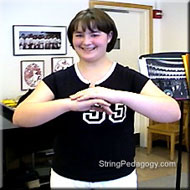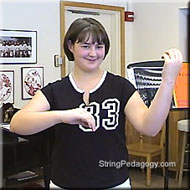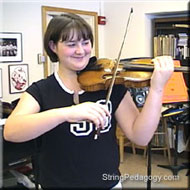Stance, rest position, Magic “X”, Statue of Liberty, playing position, balance
Part 2: GETTING THE STUDENT READY: The Physical Set-Up
Some students may accomplish all these tasks in the first lesson; others may take longer or go further. This depends on age, ability to concentrate and enthusiasm. Creating a positive learning environment is more important than covering a certain amount of material. The child's love of music and of playing is paramount.
Clip Title:
|
Getting the Student Ready | |
Description: |
Stance, rest position, Magic “X”, Statue of Liberty, playing position, balance |
|
Channel: |
102 | |
Duration: |
5'23" |
The student should be comfortably erect, with soft knees, head on top
of the backbone, and no swayback or protruding tummy. The shoulders should
be balanced over the hips and ankles. If a student is slumping, it is
helpful to place one finger on the belly button and one finger on the
sternum notch. (Exercises for this are found in Volume II.) Visualize
the backbone lengthening as space is created between the vertebrae. Many
of these principles of posture are drawn from contact with teachers of
the *Alexander Technique.
WILL BE CAREFULLY MONITORED FOR THE NEXT DECADE!
Rest
Position:
(The violin is tucked gently under the right arm): Rest the left
hand over the high dot in rest position and slide along the neck on the
"Magic X". The Magic X is placed at base joint of the left index
finger (on the first crease). As you slide back and forth, bounce
the hand gently off the upper bout of the violin. Make sure that
the left thumb is flexible and travels with the hand. This exercise
helps relax the arm, pre-sets the shifting motions, and allows the student
to become comfortable with the instrument.

Statue
of Liberty:
Place left hand fingers over the high dot, keeping the thumb behind the
neck of the violin. Extend the left arm above the head and to the left
side. The lower half of the back of the violin is at eye level. The left
hand should remain over the high dot. The head remains balanced on
top of the neck. The eyes are directed forward.
Playing
Position:
Balance the violin in a comfortable place on the collarbone. The jaw will
rest on the chinrest keeping the head in its normal position. The
head remains flexible: the student can look out of the corner of
the eyes to observe the fingers. (Remind the student that we are not fish
with eyes on the side of our heads.) The shoulder blades will be as low
as possible to ensure that the instrument is supported by the larger muscles
of the lower back. The student can do this by raising the shoulders,
slowly rolling them back, and then gradually letting them down until they
are as low as they can go. The left hand rests over the high dot whenever
the fingers are not being used.
The
Issue of Balance:
It is helpful to locate the center of the body without the violin. To
do this, place one hand over the other to form a circle. (see picture)
Then open the arms to the violin playing position and have the teacher
place the violin on the collarbone. Have the student move the head
in "yes" and "no" directions to ensure that neither
the head nor the shoulder is gripping the violin.
 |
 |
 |
 |
| < 1 > | < 2 > | < 3 > | < 4 > |
The sliding exercise used in rest position is now applied to playing position. It helps to develop a sense of balance between the hand, jaw and shoulder, and encourages the student to hold the violin with a flexible hand and well-balanced head. It is also an excellent preparation for placing the hand in first position and for shifting. Again, the teacher should always be aware of the relationship of the head, neck and back.